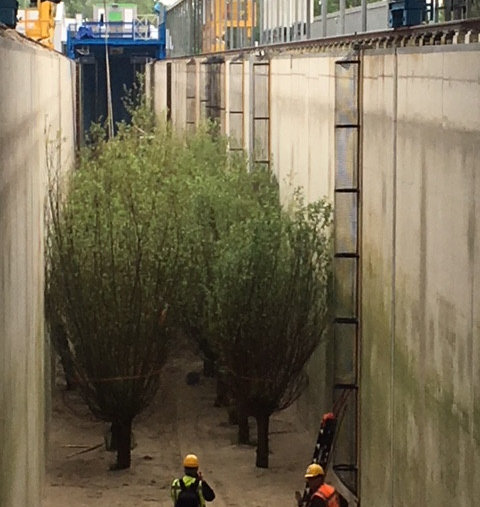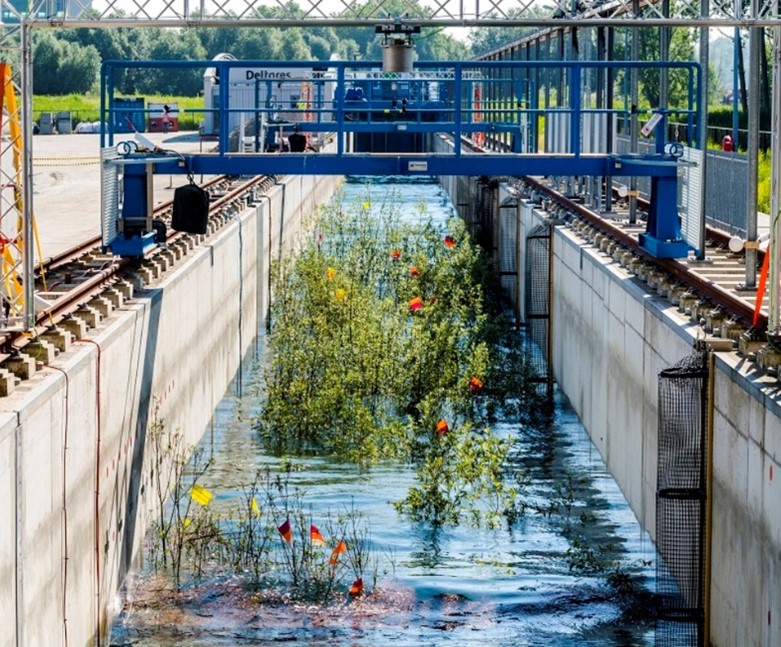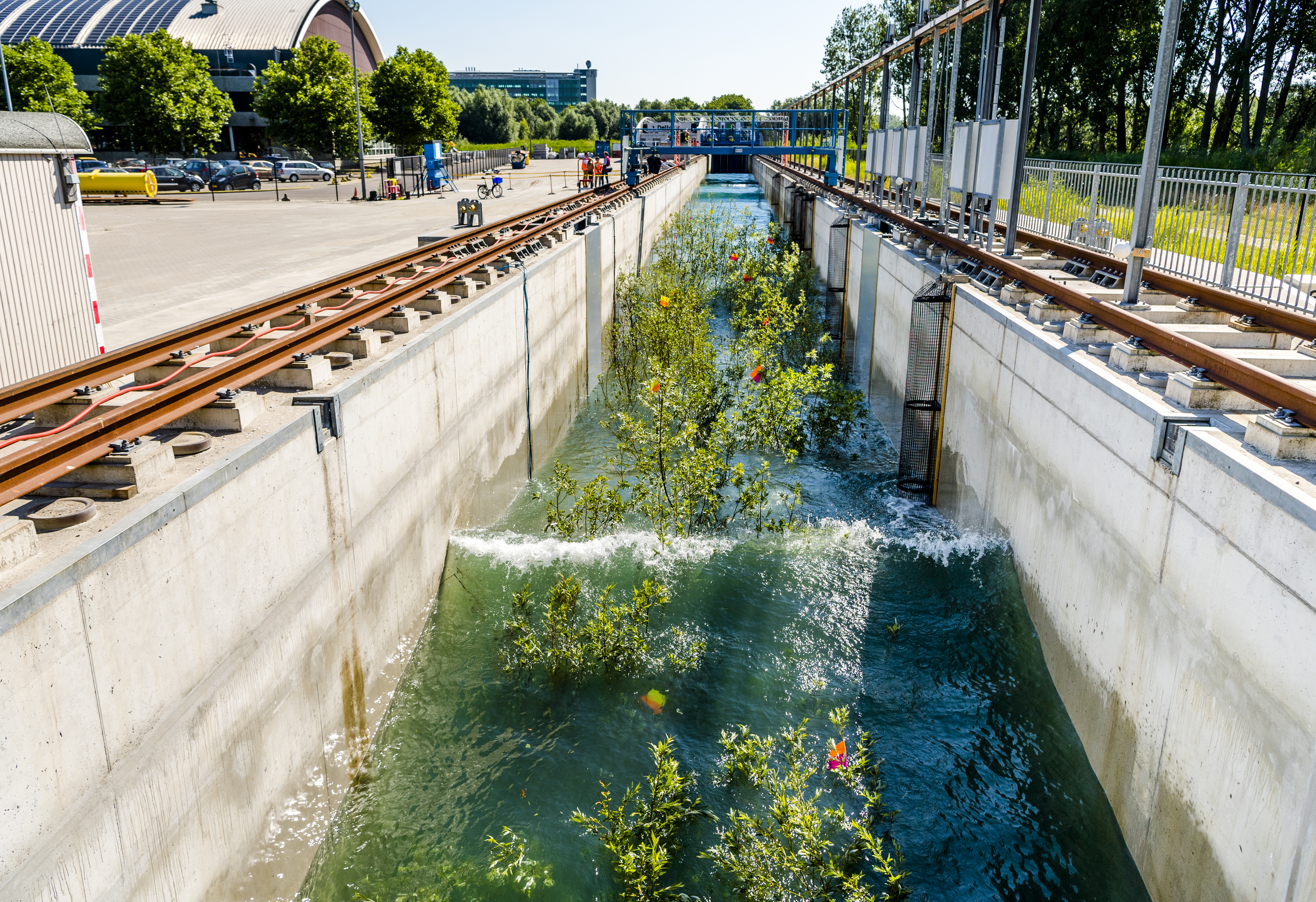Pollard willows stop waves
Much is being said about how nature can help to protect us from flooding. Forests, for example, could play a role in dampening the waves that approach a dike. Until now, however, there has been little quantitative evidence of how trees function under extreme conditions. How well do trees dampen waves during a big storm and when do they break? To quantify this, in 2018 Deltares, TU Delft and NIOZ tested a 40 metres wide forest of typical Dutch pollard willows in the world's largest wave flume, the Delta Flume. The trees were attacked by large waves of up to two and a half metres high. The results show that trees are well suited for dampening waves. This week, the team of researchers published the first results in Scientific Reports. The article provides insight into how we can best make use of trees and the power of nature for our water safety.
The trees stayed upright, wave height was reduced
The most important conclusion is that the trees can indeed work to dampen waves. The trees remained intact at maximum wave heights of 2.5 metres. The forest reduced the wave height up to 22%. In reality, however, trees can be taller or shorter and more or less densely packed. To estimate how a forest attenuates waves in reality, good calculation models are needed. Existing models to calculate the wave attenuation caused by the branches were found to work reasonably well, as long as the structure of the trees is accurately known. Mapping this structure of trees on the other hand proved to be more difficult than expected, but it eventually succeeded.
The trees attenuated wave energy most at medium-high water levels, where the wave passes right through the crown and thus encounters the most tree surface. Surprisingly enough, the leaves on the trees hardly contributed to the wave attenuation. The willows tested were also much more flexible than previously thought and the branches moved somewhat with the waves. Perhaps this reduced the trees' damping capacity during the very high and longer waves – which is something to investigate further.
Hybrid flood defences
The results of the experiment in the Delta flume laid the foundation for the NWO research project WOODY, which kicked-off in 2020. WOODY project leader Bas Hofland: "The aim of WOODY is to develop the knowledge that is urgently needed to design hybrid flood defences. These are flood defences that combine nature and a hard dike. Trees can then be a functional part of a flood defence, as has already been implemented at one location in the Netherlands."
Bregje van Wesenbeeck: "Especially with climate change and a rising sea level, we have to learn to work better with the naturally present systems. The research in WOODY focuses on better mapping the functions of those systems that can help us achieve this, so that we can start designing better solutions for different coastlines and river areas in the world. Combinations of natural landscapes and hard defences are promising and can make many places in the world a lot safer. This study is an important step in making design rules for such innovative designs. For example, we can now calculate much better how long a forest should be in front of a dike to achieve the desired wave attenuation.
In WOODY, researchers Bas Hofland, Bregje van Weesenbeeck, Su Kalloe and Alejandra Gijón from Delft University of Technology refine the calculation models and measurement methods used to determine the wave attenuation by trees. They also study how the damping effect of trees can be tested in smaller-scale and less expensive experiments.
3D printed trees
Su Kalloe is a PhD student and co-author of the paper. She has accurately measured all the willows in the large wave flume. "Based on those measurements, I estimated the exact shape and surface area of each tree. We use this tree model to calculate the wave attenuation of trees under extreme conditions." Based on the tree model, Kalloe can now 'grow' realistic small trees from the 3D printer, so that the large-scale tests outlined in the Scientific Reports article can be replicated and expanded on a small scale. She will use the 3D printed trees to see to what extent the flexibility of the branches does indeed reduce the wave attenuation capabilities of trees.
Biodiversity
In a work package led by Tjeerd Bouma of NIOZ, PhD student Corinne van Starrenburg focuses on the natural value of the forests. In addition to safety, these solutions can also contribute to important nature objectives. "Further optimising design rules which maximise biodiversity in addition to safety is a key challenge that we are focusing on in our field studies," says Tjeerd Bouma. "That is why, among other things, the biodiversity of various types of willow forests is being determined. Ultimately, this should make it possible to construct or grow a forest for wave attenuation, while it also exhibits a great wealth of biodiversity."
And beyond
Ultimately, WOODY aims to combine the results of the various work packages into design rules that can be used to design hybrid flood defences with forests that are both safe and of high nature value.
Site-specific research will also continue to be necessary in the future. Bas Hofland: "If we are serious about including the role of nature in our water safety, we will have to subject different types of trees to equally thorough testing. These large-scale tests on the typically Dutch pollard willow show that this is well possible." That is why the parties involved in the first large scale test series, are also preparing for follow-up research in the Delta flume with mangrove trees, which grow in tropical areas along coasts and are also now growing in a greenhouse at Deltares.
More information:
Partners in WOODY zijn: Boskalis, Van Oord, Deltares, Rijkswaterstaat, WNF/WWF.
Scientific Reports paper, Wave attenuation through forests under extreme conditions: www.nature.com/articles/s41598-022-05753-3
Bas Hofland (TU Delft): B.Hofland@tudelft.nl
Bregje van Wesenbeeck (Deltares, TU Delft): B.K.vanWesenbeeck@tudelft.nl
Tjeerd Bouma (NIOZ): Tjeerd.Bouma@nioz.nl







